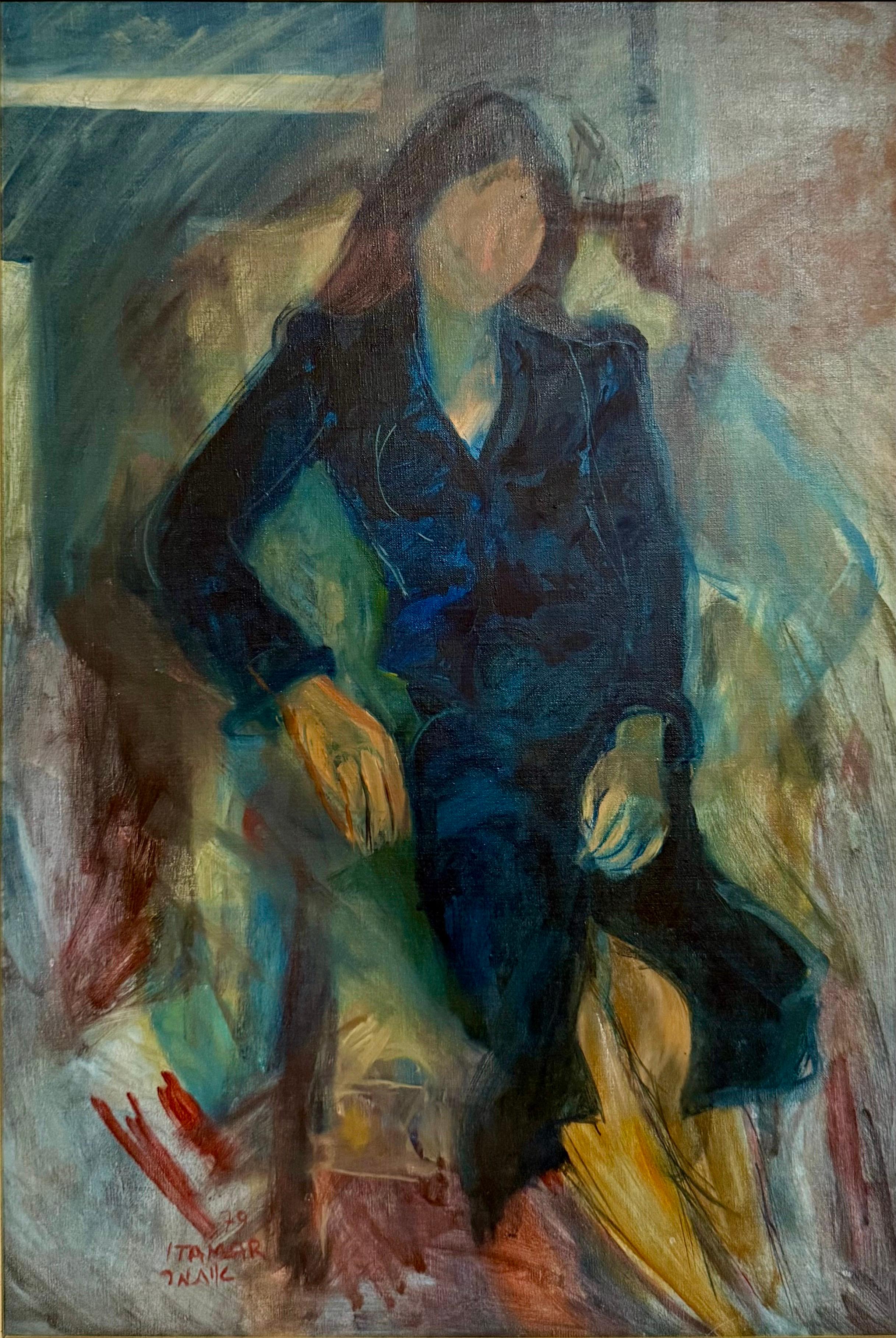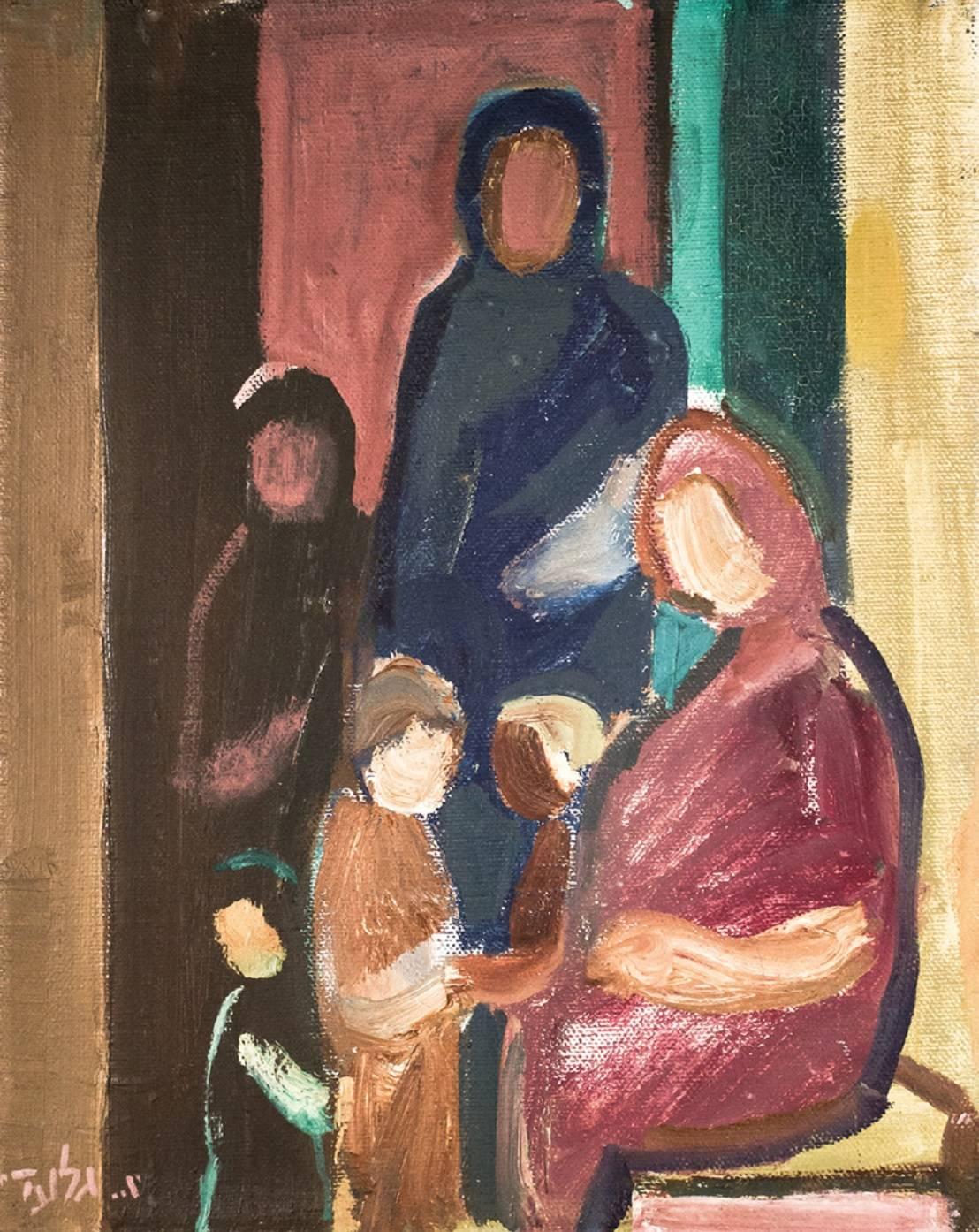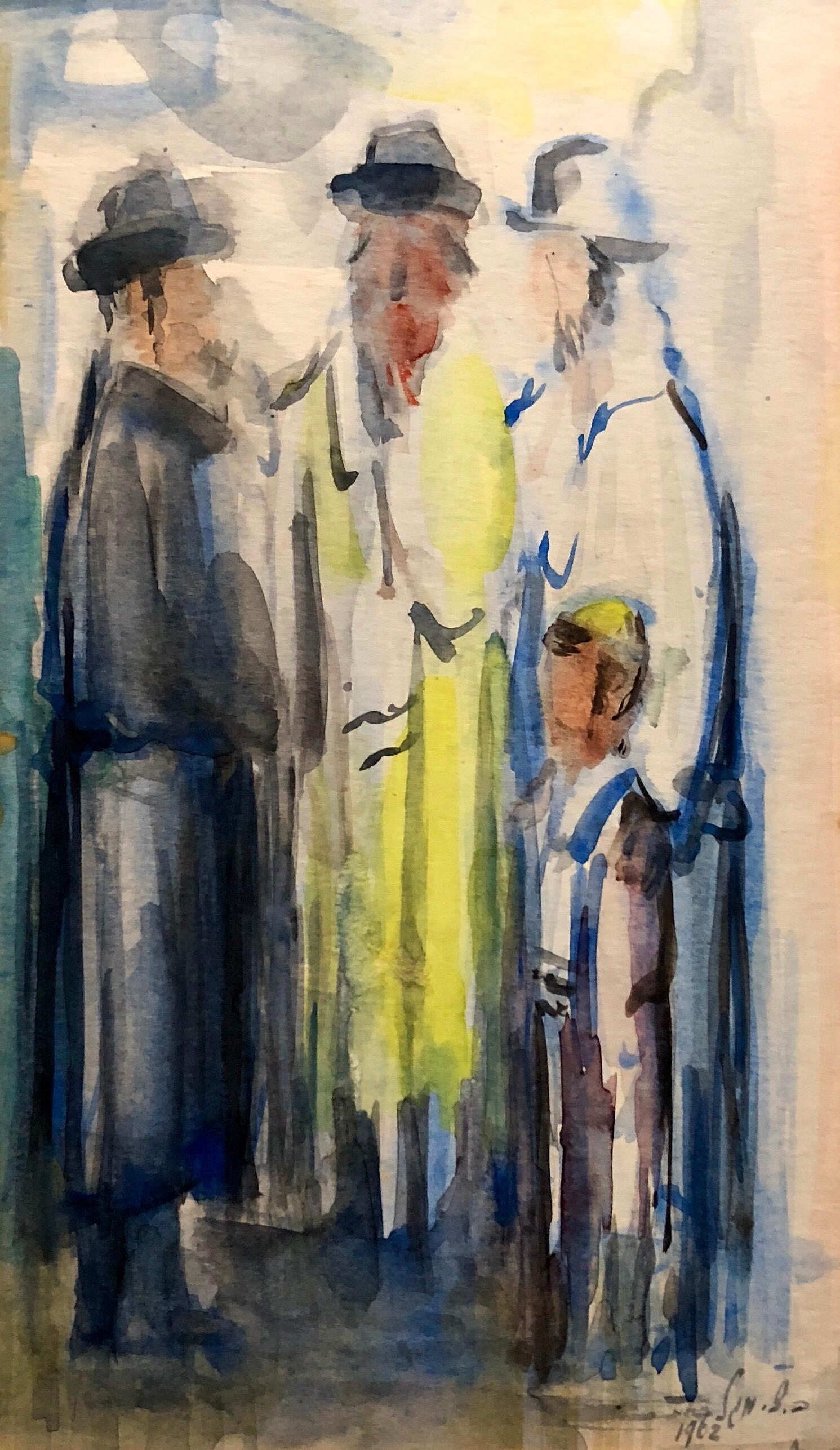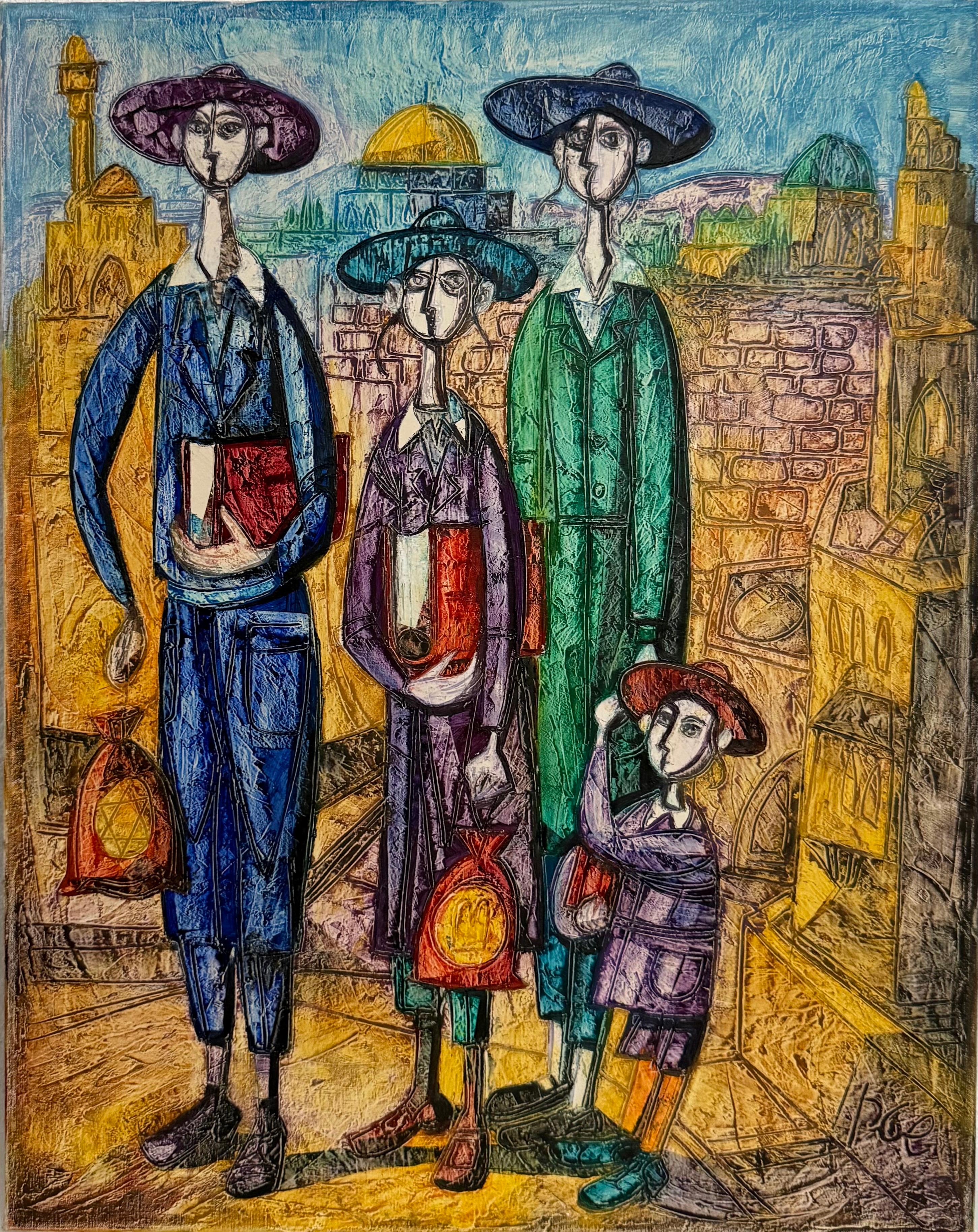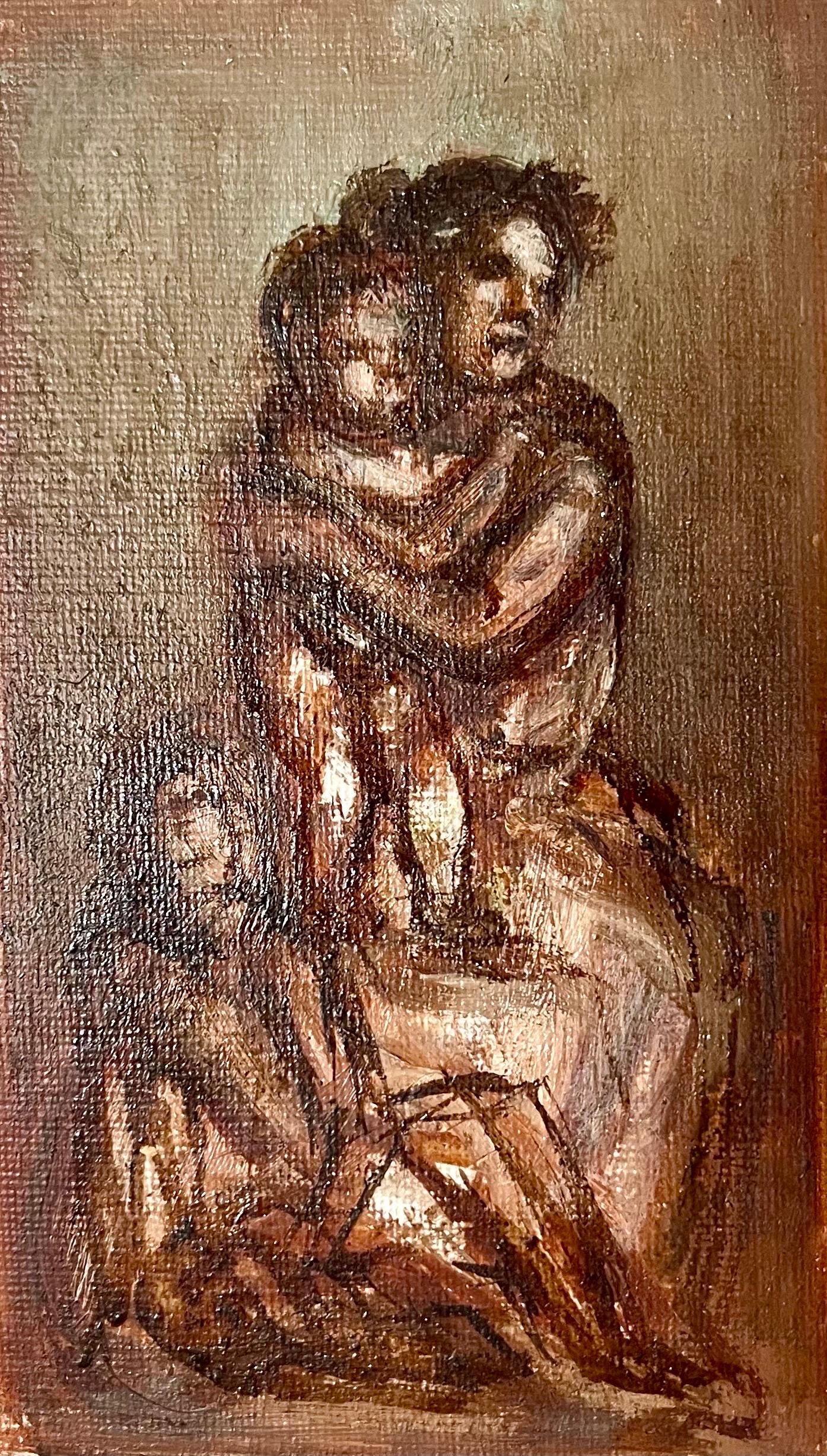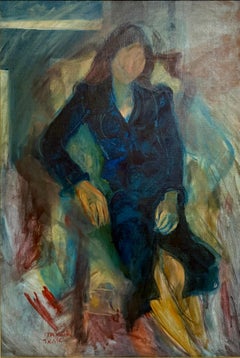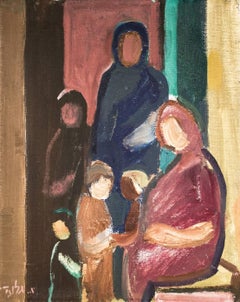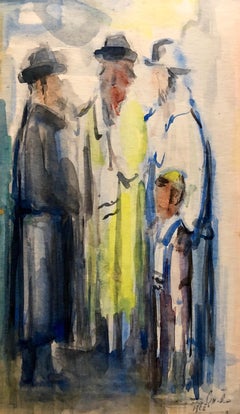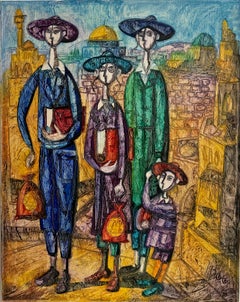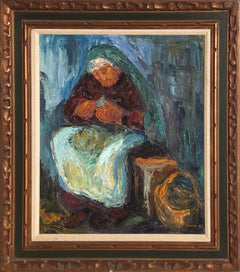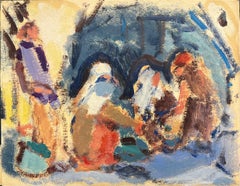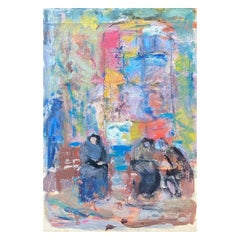Items Similar to Rare Jewish Yemenite Family Oil Painting Israeli Judaica Itamar Siani
Want more images or videos?
Request additional images or videos from the seller
1 of 18
Itamar SianiRare Jewish Yemenite Family Oil Painting Israeli Judaica Itamar Siani1981
1981
$2,000
£1,517.55
€1,735.19
CA$2,793.46
A$3,105.94
CHF 1,621.75
MX$37,806.91
NOK 20,692.86
SEK 19,388.22
DKK 12,950.02
Shipping
Retrieving quote...The 1stDibs Promise:
Authenticity Guarantee,
Money-Back Guarantee,
24-Hour Cancellation
About the Item
Itamar Siani, Israeli artist, painter, engraver, born 1941, Yemen
His art commemorates the unique cultural heritage and traditions of the Yemenite Jewish community, who returned to the Promised Land on "Eagles' Wings," the code name of the Israeli rescue of Yemenite Jewry in 1949. Among his notable works is a ten-meter long oil painting depicting the immigration of the Yemenite Jews, which he worked on for 30 years.He did a celebrated series titled "The Magic Carpet" etchings depicting stages in the artist’s life including: Liberation, The Magic Carpet, Refugees, New life in Israel, Family, Mount Sinai. published in Jerusalem 1973. The artist was born in Sana’a in Yemen and flown to Israel aged 5 years old as part of operation ‘Magic Carpet’ the mass migration that transported almost the entire Jewish population of this part of the Arabian peninsula to the new State. The etchings continue and develop a long tradition of Yemenite artistry. Yemenite born Israeli painters Avshalom Okashi, Dov Boussani, Matti Bassis, Yosef Halevi, Raphael Vakhash, Mikhael Khashbi, Itamar Siani, Avraham Atsmon, David Tamari, Benyamin Levy, Khaim Twili.
Itamar Siani was born in Sana'a, Yemen. He immigrated to Israel in 1949 with his mother and three brothers. He lived and studied at Meir Shfeya Youth Village near Zichron Yaakov, where the teachers recognized his artistic talent. In 1968, he was admitted to Goldsmiths College of Art in London on a scholarship from Lady Edith Wolfson.
In 1970, Siani was chosen to represent Israel in an exhibit of Israeli art at Museum Merida in Spain.
Education
1956 studied art with Marcel Janco, Zvi Mairovich, Yaacov Agam, Yohanan Simon, Prof. Josef Schwarzman, and Moshe Mokadi
1968-1975 Goldsmiths College of Art, University of London, London, England
Teaching
Painting, at his studio at Meir Shfeya Youth Village
Awards And Prizes
1963-64, Scholarship from Aliyat Hanoar
Exhibits include the Tribute to Collector Arie Dobron, Paintings, Petach Tikva Museum of Art,
Artists: Shmuel Bonneh, Samuel Tepler,Alexander Bogen, Esther Peretz Arad, Yosl Bergner, Itamar Siani, Naftali Bezem, Audrey Bergner, Ivan Schwebel.
Exhibition of Paintings The Municipal Museum - Beit-Emanuel, Ramat Gan
Artists: Pinchas Abramovich, Lea Avisedek, Albert Goldman, Shaul Ohaly, Robert Baser, Claire Szilard, Itamar Siani, Oded Feingersh, Ludwig Schwerin,
Sephardi Jews, also known as Sephardic Jews, Sefardim are a Jewish ethnic division originating from traditionally established communities in the Iberian Peninsula (modern Spain and Portugal). The term "Sephardim" also sometimes refers to Mizrahi Jews (Eastern Jewish communities) of Western Asia and North Africa. Largely expelled from the Iberian Peninsula in the late 15th century, they carried a distinctive Jewish diasporic identity with them to North Africa, including modern day Morocco, Algeria, Yemen, Tunisia, Libya, and Egypt; South-Eastern and Southern Europe, including France, Italy, Greece, Bulgaria, and North Macedonia; Western Asia, including Turkey, Lebanon, Syria, Iraq, and Iran; as well as the Americas (although in smaller numbers compared to the Ashkenazi Jewish diaspora); and all other places of their exiled settlement. They sometimes settled near existing Jewish communities, such as the one from former Kurdistan, or were the first in new frontiers, with their furthest reach via the Silk Road.
- Creator:Itamar Siani (1941)
- Creation Year:1981
- Dimensions:Height: 18 in (45.72 cm)Width: 22 in (55.88 cm)
- Medium:
- Movement & Style:
- Period:
- Condition:good. has an old repair verso. probably done by artist.
- Gallery Location:Surfside, FL
- Reference Number:1stDibs: LU38211128912
About the Seller
4.9
Platinum Seller
Premium sellers with a 4.7+ rating and 24-hour response times
Established in 1995
1stDibs seller since 2014
1,784 sales on 1stDibs
Typical response time: <1 hour
- ShippingRetrieving quote...Shipping from: Surfside, FL
- Return Policy
Authenticity Guarantee
In the unlikely event there’s an issue with an item’s authenticity, contact us within 1 year for a full refund. DetailsMoney-Back Guarantee
If your item is not as described, is damaged in transit, or does not arrive, contact us within 7 days for a full refund. Details24-Hour Cancellation
You have a 24-hour grace period in which to reconsider your purchase, with no questions asked.Vetted Professional Sellers
Our world-class sellers must adhere to strict standards for service and quality, maintaining the integrity of our listings.Price-Match Guarantee
If you find that a seller listed the same item for a lower price elsewhere, we’ll match it.Trusted Global Delivery
Our best-in-class carrier network provides specialized shipping options worldwide, including custom delivery.More From This Seller
View AllRare Jewish Yemenite Woman Oil Painting Israeli Girl Judaica Itamar Siani
By Itamar Siani
Located in Surfside, FL
Itamar Siani, Yemenite Israeli (Born 1941)
Oil on Canvas
"Portrait of a Seated Woman"
Hand signed lower left
Dimensions: 26.25" x 17.75". Frame measures 38.25" x 30"
Itamar Sian...
Category
1970s Neo-Expressionist Figurative Paintings
Materials
Canvas, Oil
Family, Mother, Children, Modernist Israeli Oil Painting Aharon Giladi
By Aharon Giladi
Located in Surfside, FL
Aharon Giladi was born in 1907 in Russia. He studied in Leningrad and in 1929 came to Israel, where he was until 1949 a member of a kibbutz in the Jordan Valley.
His dynamic line...
Category
Mid-20th Century Modern Figurative Paintings
Materials
Oil
Israeli Judaica Watercolor Gouache Bar Mitzvah Boy Rabbi Painting Russian Artist
By Ben Zion Magal
Located in Surfside, FL
Ben Zion Magal (1908 - 1999)
Ben Zion Magal was born in 1908 in Kishinev - Russia and there, years later, graduated from the Art Academy. He arrived to Erertz Israel together with hi...
Category
1960s Neo-Expressionist Figurative Paintings
Materials
Watercolor, Gouache
Jerusalem Hasidic Family Oil Painting Israeli Judaica Yossi Stern Bezalel School
By Jossi Stern
Located in Surfside, FL
Jossi Stern Hungarian Israeli 1923- 1992)
Untitled (Figures, Chassidic Family, Father and Sons),
Oil on canvas,
Hand signed lower right,
Provenance: gallery label (Safrai Art Gall...
Category
20th Century Modern Figurative Paintings
Materials
Canvas, Oil
Large Judaica Oil Painting Samuel Grodensky Hasidic Rabbi, Children in Jerusalem
Located in Surfside, FL
Samuel Grodensky (1894-1974)
"Hassidim"
Hand signed and dated "Grodensky '62" u.l.,
Titled verso in pencil on stretcher
31" x 27" canvas , 35 1/2" x 31 1/2" framed.
Large Fauvist Expressionist Jewish Family Oil Painting
This is done in an Expressionist style in Fauvist colors. Influenced by the Judaic artists of the early Israeli...
Category
1960s Expressionist Figurative Paintings
Materials
Canvas, Oil
Simka Simkhovitch WPA Artist Oil Painting Family Mother, Kids American Modernist
By Simka Simkhovitch
Located in Surfside, FL
Simka Simkhovitch (Russian/American 1893 - 1949)
This came with a small grouping from the artist's family, some were hand signed some were not.
These were studies for larger paintings.
Simka Simkhovitch (Симха Файбусович Симхович) (aka Simka Faibusovich Simkhovich) (Novozybkov, Russia May 21, 1885 O.S./June 2, 1885 N.S.—Greenwich, Connecticut February 25, 1949) was a Ukrainian-Russian Jewish artist and immigrant to the United States. He painted theater scenery in his early career and then had several showings in galleries in New York City. Winning Works Progress Administration (WPA) commissions in the 1930s, he completed murals for the post offices in Jackson, Mississippi and Beaufort, North Carolina. His works are in the permanent collections of the Dallas Museum of Art, the National Museum of American Art and the Whitney Museum of American Art. Born outside Kyiv (Petrograd Ukraine) into a Jewish family who owned a small department store. During a severe case of measles when he was seven, Simcha Simchovitch sketched the views outside his window and decided to become an artist, over his father's objections. Beginning in 1905, he studied at the Grekov Odessa Art School and upon completion of his studies in 1911 received a recommendation to be admitted to the Imperial Academy of Arts. Though he enrolled to begin classes in architecture, painting, and sculpture at the Imperial Academy, he was dropped from the school roster in December because of the quota on the number of Jewish students and drafted into the army. Simchovitch served as a private in the 175th Infantry Regiment Baturyn [ru] until his demobilization in 1912. Re-enrolling in the Imperial Academy, he audited classes.
Simka Simkhovitch exhibited paintings and sculptures in 1918 as part of an exhibition of Jewish artists and in 1919 placed 1st in the competition "The Great Russian Revolution" with a painting called "Russian Revolution" which was hung in the State Museum of Revolution. In 1922, Simkha Simkhovitch exhibited at the International Book Fair in Florence (Italian: Fiera Internazionale del Libro di Firenze). In 1924, Simkhovitch came to the United States to make illustrations for Soviet textbooks and decided to immigrate instead. Initially he supported himself by doing commercial art and a few portrait commissions. In 1927, he was hired to paint a screen for a scene in the play "The Command to Love" by Fritz Gottwald and Rudolph Lothar which was playing at the Longacre Theatre on Broadway. Art dealers began clamoring for the screen and Simkhovitch began a career as a screen painter for the theater. Catching the attention of the screenwriter, Ernest Pascal, he worked as an illustrator for Pascal, who then introduced him to gallery owner, Marie Sterner. Simkhovitch's works appeared at the Marie Sterner Gallery beginning with a 1927 exhibit and were repeated the following year. Simkhovitch had an exhibit in 1929 at Sterner's on circus paintings. In 1931, he held a showing of works at the Helen Hackett Gallery, in New York City and later that same year he was one of the featured artists of a special exhibit in San Francisco at the California Palace of the Legion of Honor in Lincoln Park. The exhibit was coordinated by Marie Sterner and included four watercolors, including one titled "Nudes". He is of the generation of Russian Soviet artists such as Isaac Pailes, Serge Charchoune, Marc Chagall, Chana Orloff, Isaac Ilyich Levitan, and Ossip Zadkine.
In 1936, Simkhovitch was selected to complete the mural for the WPA Post office project in Jackson, Mississippi. The mural was hung in the post office and courthouse in 1938 depicted a plantation theme. Painted on the wall behind the judge’s bench, “Pursuits of Life in Mississippi”, a depiction of black workers engaged in manual labor amid scenes of white professionals and socialites, was eventually covered over in later years during renovations due to its stereotypical African American imagery. The following year, his painting "Holiday" won praise at an exhibition in Lincoln, Nebraska. In 1940, Simkhovitch's second WPA post office project was completed when four murals, "The Cape Lookout Lighthouse and the Orville W. Mail Boat", "The Wreck of the Crissie Wright", "Sand Ponies" and "Canada Geese" were installed in Beaufort, North Carolina. The works were commissioned in 1938 and did not generate the controversy that the Jackson mural had. The main mural is "The Wreck of the Crissie Wright" and depicts a shipwreck which had occurred in Beaufort in 1866. "The Cape Lookout Lighthouse and the Orville W. Mail Boat" depicted the lighthouse built in 1859 and the mail boat that was running mail during the time which Simkhovitch was there. The boat ran mail for the area until 1957. "Sand Ponies" shows the wild horses common to the North Carolina barrier islands and "Canada Geese" showed the importance of hunting and fishing in the area. All four murals were restored in the 1990s by Elisabeth Speight, daughter of two other WPA muralists, Francis Speight...
Category
1930s American Modern Figurative Paintings
Materials
Oil, Board
You May Also Like
"Pharaoh Group" Oil Painting 13" x 17" inch (1955) by Shaaban Zaki
By Shaaban Zaki
Located in Culver City, CA
"Pharaoh Group" Oil Painting 13" x 17" inch (1955) by Shaaban Zaki
Shaaban Zaki came from a lower-middle-class family who was mostly government employees, but he was distinguished f...
Category
20th Century Expressionist Portrait Paintings
Materials
Wood, Oil
Mother, Oil Painting by Chaim Goldberg
Located in Long Island City, NY
Artist: Chaim Goldberg, Israeli (1917-2004)
Title: Mother
Medium: Oil on Canvas, signed in English lower left and Hebrew lower right
Size: 24 x 20 inche...
Category
1970s Expressionist Portrait Paintings
Materials
Oil, Canvas
20th Century German Modernist Oil Painting - Busy Figures
Located in Cirencester, Gloucestershire
Artist: Elisabeth Hahn (German 1924-2021),
Elisabeth Hahn was born in Dortmund, Germany, where she began her artistic studies. In 1953, she moved to P...
Category
20th Century Modern Figurative Paintings
Materials
Oil
20th Century German Modernist Oil Painting Figures Colorful Street Scene
Located in Cirencester, GB
Artist: Elisabeth Hahn (German 1924-2021),
Elisabeth Hahn was born in Dortmund, Germany, where she began her artistic studies. In 1953, she moved to Paris. She continued her stud...
Category
20th Century German Mid-Century Modern Paintings
Materials
Other
Mother and Daughter, Oil Painting by Sandu Liberman
By Sandu Liberman
Located in Long Island City, NY
Artist: Sandu Liberman, Romanian/Israeli (1923 - 1977)
Title: Mother and Daughter
Year: Circa 1970
Medium: Oil on Canvas, signed l.r.
Size: 36 x 24 in. (91.44 x 60.96 cm)
Frame Size:...
Category
1970s Expressionist Figurative Paintings
Materials
Oil
Original Vintage Oil Painting on board, Family, People, Portrait, signed, framed
Located in Palm Coast, FL
Up for sale is an original oil painting on board depicting a family portrait. Very textured.
Indistinctly signed lower right. Looks to read W. Satter. Painted with impasto and scra...
Category
20th Century Impressionist Portrait Paintings
Materials
Oil
$304 Sale Price
20% Off
More Ways To Browse
Oil Painting South African
Jew Painting
Judaica Paintings
Magic Carpet
Algeria Painting
Oil Painting Turkish Artists
Jewish Oil Canvas
Oil Painting Of North Africa
Oil Paintings Portugal
Jewish Etching
Moroccan Oil Painting
Oil Painting Morocco
Modern Judaica Painting
Syrian Paintings
Syrian Art Painting
15th Century Oil Painting
Raphael Oil Paintings
Spanish Jewish
